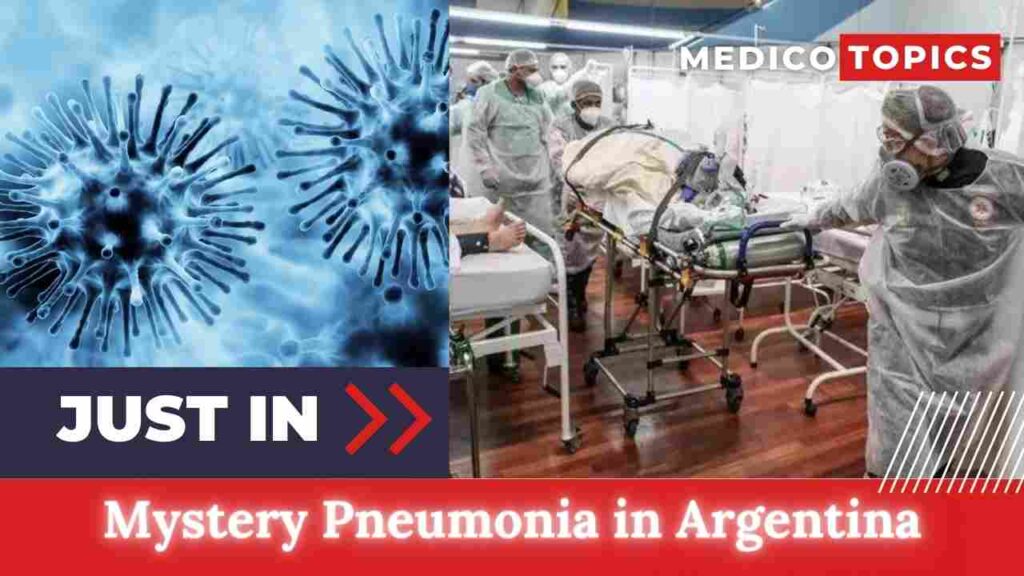
In an alarming new outbreak of an unidentified deadly virus, mysterious pneumonia claimed the lives of three people in Argentina this week. Let’s see about the mystery Pneumonia in Argentina and what is origin of infection in detail
Mystery Pneumonia in Argentina
Nine people have contracted the unidentified ailment, which has been labeled “pneumonia of unknown origin” and is comparable to Covid, and three people have passed away. Doctors have ruled out Covid, influenza, and hantavirus as causes of the mystery ailment, which is affecting five additional people in hospitals in Argentina. According to the Tucumán Ministry of Health, nine persons in the same private medical unit have already contracted the unidentified ailment. The distance between Tucumán and Buenos Aires, the capital city of Argentina, is 800 miles. After three people passed away in Argentina this week from an unexplained incidence of pneumonia, concerns over a new fatal viral outbreak have started to spread.

What did Argentine health officials report?
Six more patients have also contracted “pneumonia of unknown origin,” according to Argentine health officials. Eight of the nine infected people were medical professionals, while the ninth was an ICU patient receiving care at a private clinic in Tucumán, a small region located 800 miles northwest of the Argentine city of Buenos Aires.
As testing for 30 illnesses, including COVID, the flu, and influenza types A and B came back negative, health experts have expressed growing concerns, Tucumán Health Minister Luis Medina Ruiz reported to local news sources on Wednesday.
Acute respiratory illness, bilateral pneumonia, and compromise in the [Z-ray] scans are what these patients have in common, but COVID has been ruled out, according to Ruiz.
Since Tuesday, the European Centre for Disease Control’s epidemic intelligence team has been tracking the cases, and World Health Organization scientists have also been keeping tabs on the situation.
According to professor Devi Sridhar, head of global health at Edinburgh University and author of “Preventable: How a Pandemic Changed The World & How to Stop the Next One,” “it’s worrying but we still need important information on transmission and hopefully [on the] underlying cause.”
The Malbran Institute in Buenos Aires and the National Administration of Health Laboratories and Institutes in Argentina have reportedly received samples of the unidentified virus for examination. To check for potential poisoning, local officials are also testing the water and air conditioning systems in the region.
The infection most recently claimed the life of a 70-year-old lady on Thursday. Before a procedure, she had been admitted to the clinic where the infected medical staff members practiced. Although Ruiz stressed that the information is still “being examined,” it has been assumed that the elderly woman was “patient zero.”
After all, both patients had “a serious respiratory disease with bilateral pneumonia… extremely similar to COVID,” with the first passing away on Monday and the second on Wednesday. The first six victims’ symptoms appeared between August 18 and August 22. The three most recent infected individuals have not yet shown symptoms, although officials have noted that two are having clinical care and one is being followed at home. This occurs over 2.5 years after the global COVID-19 outbreak started to spread. Since then, several other infections have raised concerns about the possibility of a new pandemic, with monkeypox recently prompting a state of emergency in the US.
What symptoms do affected patients experience?
The unexplained respiratory illness has been diagnosed in eight members of the medical staff at the private clinic, according to Tucuman’s health minister, Luis Medina Ruiz. This may indicate that the illness is contagious.
The outbreak, which is claimed to have symptoms like vomiting, a high temperature, and diarrhea, is currently being investigated by authorities. The Malbran Institute in Buenos Aires has received samples from affected patients for additional analysis.
The first six cases of the sickness’ symptoms were noted between August 18 and August 22, however, three more people have subsequently contracted the ailment. According to the health minister, two of those admitted to hospitals since August 22 need mechanical breathing support and are in critical condition. According to reports, the third is being watched at home.
Six individuals are still being treated as a result; four are reportedly in serious condition, while two are being kept in isolation at home. The acute respiratory state with bilateral pneumonia and compromise in [x-ray] images very similar to Covid is what these patients have in common, Mr. Ruiz told local media on Wednesday, although that has been ruled out.
What did Mr. Ruiz say about the outbreak?
Although no virus has been discovered to date, environmental or chemical reasons have not yet been ruled out. We are all attentive to this issue, Mr. Ruiz stated. “We are disseminating guidelines to public and private intensive care units for the potential appearance of a patient with these characteristics, particularly to make a correct diagnosis with all the required protocols and PPE, as recommended with all patients with respiratory conditions,” the statement reads.
Given that no cases have had direct contact with any patients, Hector Sale, president of the Tucuman Provincial Medical College, stated that there has been no conclusive evidence of person-to-person transmission. We are not dealing with a sickness that spreads from person to person, he declared.
KEEP READING,
How did Bamba Bakya die? Cause of Death Revealed
What is Plant-based diet? How much effective is it? Explained
Follow us on Twitter to get instant notifications on the latest news.
Lavanya (Senior Editor) is a full-time content writer with almost 5 years of experience and a part-time teacher. She joined Medico Topics on the Breaking News trainee scheme in 2022 and now works on MedicoTopics.com. As a lifelong learner, She is constantly curious about learning new things and passionate about sharing knowledge with people through her writing and teaching.
